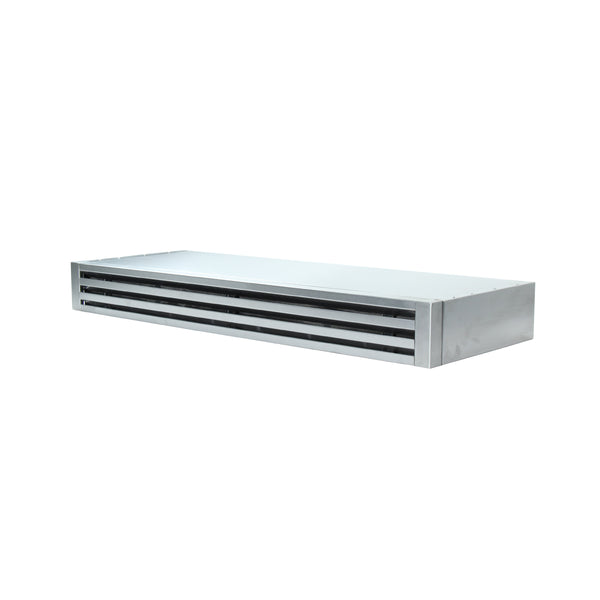You open your fridge and take out some kale to make a kale salad. But it’s wilted! Darn! Have you wondered what to do with wilted kale or is wilted kale still good? Probably. Read on.
Luckily, reviving wilted kale is so easy to do. Check out the video below.
All you need to do is cut about an inch off of the end of the kale stem. Fill your sink or a large bowl with cold water and set the kale inside. Let the kale sit for anywhere from 4 to 10 hours or overnight and remove it from the water in the morning. Poof! Like magic, it will be crisp and usable. I have done it many times!
Make sure that you submerge all the kale pieces, including the stems in the water. It’s not effective to just soak the stems or parts of the kale leaves.
Check out this quick video below to learn how to revive wilted kale fast.
We’ll do a quick breakdown of the steps below.
Have you ever wondered if you can revive lettuce in the same way?
1. Cut a bit off the end of the kale stem.
The stems dry out on the ends and make it hard to revive the kale. Cutting off the stems also allows the kale to absorb the water you are about to give it.
2. Fill your (clean) sink or a large bowl with water.
Your sink doesn’t need to be full. Just fill it about ⅓ of the way or enough to make sure the kale is fully submerged.
3. Set the kale in your bowl or sink.
You don’t need to turn the kale to wet both sides. You can just lie it flat in the bowl or sink and wait. The water will absorb into the leaves and the stem over time. Just make sure to lie it flat. If you put the kale in your sink standing up, it won’t absorb the water as quickly and efficiently.
4. Wait four to 10 hours, or overnight.
Like most veggies, kale wilts because it becomes dehydrated over time. Eventually, it loses its green color and turns yellow, then brown. Rehydrating your kale overnight will make it fresh and delicious again!
Try this technique with other greens, like parsley, broccoli, celery, and many others!

Can kale go bad?
Yes, kale can go bad. If it’s stored correctly, I find it lasts around two weeks in the fridge. Keep in mind how old it was when you bought it, though. Store-bought kale won’t last as long as kale from the farmer’s market down the street or your own garden. In fact, you might need to give your store-bought kale a little pick me up immediately when you get home.
If your kale starts to yellow, it’s still safe to eat. Just cut off the stems and soak the kale in water overnight.
How to Revive Limp Wilted Celery (Fresh and new again!)
Enhance Your Kitchen with a Range Hood
While reviving wilted kale is a clever kitchen trick, maintaining an optimal kitchen environment can make all your culinary tasks easier and healthier, especially when dealing with strong odors and steam from cooking greens like kale.
A quality range hood is essential for any home chef looking to improve their cooking space. Range hoods not only ventilate smoke and reduce kitchen odors but also help in maintaining cleaner air, preventing grease build-up on surfaces. For those who enjoy cooking greens and other aromatic ingredients, consider exploring our selection at ProlineRangeHoods.com.
Here, you can find a variety of range hoods that fit any kitchen style and size, ensuring your cooking area remains fresh and inviting. Investing in a good range hood enhances your kitchen’s functionality and your home’s overall value—perfect for when you’re perfecting recipes like revitalized kale salad or crispy kale chips.
How can you tell if kale has gone bad?
Over time, kale will wilt and lose its color and smell a little funny. It will turn yellow and eventually, brown. Kale that’s yellowed a little bit is still safe to eat. But if you start to notice a sulfur or rotten egg smell, it’s time to throw your kale out. The kale leaves will also become soggy and slimy.
At that point, your kale is past reviving. It will eventually start to grow bacteria that may make you sick.
Can you eat wilted kale?
I don't recommended eating wilted kale raw. It won’t have the same flavor or texture as fresh kale. So, try to revive it. Cut off the stems and place them in water for about eight hours. That should revitalize your kale, making it crispy and delicious! If you aren't able to, try cooking it in a soup.
How to Prevent Kale from Wilting
To prevent kale from wilting, make sure to keep it in a water-tight and air-tight bag in the refrigerator. Do not store your kale in water. If it’s in water for too long, the leaves and stem will become oversaturated and wilt. Fresh kale should last about a week in the fridge.
You can also freeze kale for four to six months. Before putting your kale in the freezer, cut the stems off and place it in a freezer bag. Make sure to remove as much water or air from the bag as you can.
How long is kale good in the fridge?
Fresh kale should last about a week in the fridge. If you buy bagged kale from a store, it’ll last for about five days after it’s been opened. Be sure to check the expiration date on the bag.
Can kale last 2 weeks?
Most fresh kale lasts about a week in the fridge but bagged kale may last up to two weeks. If you want your kale to last months, store it in the freezer. Kale stays fresh for around half a year in the freezer.
How long does kale last at room temperature?
Kale will last about half a day at room temperature. So it’s important to refrigerate kale as soon as possible.
Is slimy kale bad?
Yes, slimy kale is not safe to eat. If you find white or black spots on the plant or notice a strong sulfur smell, your kale is too old to eat.
Does kale go bad if not refrigerated?
Yes, kale only lasts about half a day out of the fridge. You can freeze it for about six months, though.
Can bad kale make you sick?
Yes, if your kale is stored too long, it can develop bacteria that may make you sick. Bad kale will start to smell like sulfur or rotten eggs. Look for white, brown, or black spots on the kale, too.
If the leaves are just starting to yellow, you may be able to revive your kale. Just cut off the stems, remove the yellow parts and soak the kale in water overnight.
Is wilted kale still good?
Wilted kale can still be good, but it depends on its condition. Here's what you need to know:
1 - Visual Inspection: Wilted kale may appear limp and floppy, losing its crisp texture. This doesn't necessarily mean it's bad, but it's past its prime.
2 - Smell Test: If your kale has a sulfur or rotten egg smell, it's no longer good and should be discarded.
3 - Color Changes: Yellowing kale is still safe to eat, but if it's turning brown, it's best to throw it out.
4 - Texture: If the kale leaves become soggy and slimy, they're past the point of revival and should not be consumed.
If you can't revive your wilted kale or don't have time, you can still use it in certain ways:
- Cooking: Wilted kale can be used in cooked dishes like soups, stir-fries, or sautés.
- Smoothies: Add wilted kale to smoothies for a nutritional boost.
- Salads: If only slightly wilted, you can still use it in salads after reviving it.
Is wilted kale OK to cook?
Yes, you can cook and eat wilted kale, as long as it doesn’t grow bacteria or smell revolting. Before you cook wilted kale, though, you might as well try to revitalize it. You just need to chop the stems off, fill your sink with some water, and set the wilted kale in the sink. Wait overnight and come back to fresh leafy kale.
Click here to check out how to revive wilted or limp broccoli.
So, now you know what to do with wilted kale!
If anyone asks you how to revive kale, you know the answer.
Kale is a fantastic nutrient-packed leafy green that is a staple in many healthy diets. However, it can be frustrating when you open your fridge to find wilted kale. Don't worry! There are several ways to revive your kale and make it fresh and nutritious again.
Wilted kale is definitely still good to eat. It may not look as appealing, but it's still packed with nutrients. So, don't throw it away just yet! Make kale crispy again.
As you read above, to revive kale, start by cutting off the tough stems and separating the leaves. Fill a container with cold water and add the kale leaves. Let them soak for a couple hours. This will help to rehydrate the leaves and bring them back to life.
If you're looking to cook it you can wilt kale by sautéing it in a pan with a little bit of olive oil. This will soften the leaves and make them easier to eat. Be careful not to overcook the kale, as it will become mushy.
To keep kale from wilting in the first place, store it in a plastic bag in the fridge. Make sure to remove as much air as possible from the bag before sealing it. This will help to keep the kale fresh for longer.
If you're looking for wilted kale recipes, there are plenty of options. You can add it to smoothies, soups, or stir-fries. One delicious recipe is wilted kale salad with roasted sweet potatoes and quinoa. Simply mix the kale with the other ingredients and drizzle with a lemon vinaigrette.
**Discover the perfect range hood for your kitchen and take advantage of our special offers today by visiting our current sales and promotions page.
If your kale smells bad, it's best to throw it away. This can be a sign of spoilage and could make you sick if consumed.
Lastly, if you want to cook it and make kale crispy that way, try baking it in the oven. Spread the kale leaves on a baking sheet and drizzle with olive oil. Bake at 350°F for 10-15 minutes, or until crispy.
In conclusion, wilted kale is still nutritious and can be revived in several ways. With these tips, you can enjoy fresh and delicious kale in your meals.
When you're dealing with wilted greens like kale, spinach, swiss chard, arugula or lettuce, remember that this simple method works for reviving all leafy greens and vegetables. Don't be sad about that limp bunch of greens in your fridge - just give them a fresh start! After soaking, you can drain and toss the revived greens into a salad spinner to remove excess moisture, then sauté them with some garlic and olive oil for a delicious side dish. Or, bake them into crispy kale chips or chard chips for a tasty snack. Wilted greens may look past their prime, but with a little rehydrating magic, they'll perk up like fresh flowers and be perfect for all your cooking and food prep needs.
Related Articles
How to Make Healthy Meals for My Family
How many calories should I eat to lose weight?
How to Revive Wilted Herbs: Quick & Easy Solutions











